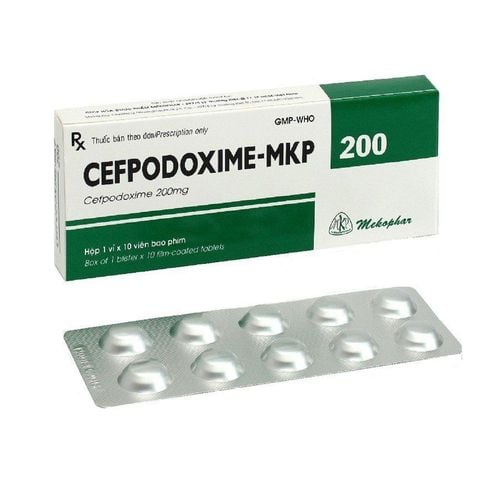This is an automatically translated article.
Cefixim is a commonly used antibiotic in the Cephalosporin group. One of the drugs containing Cefixim is Ofbexim 200. So what is Ofbexim 200 and what diseases it treats?
1. What is Ofbexim 200?
Ofbexim 200 has the main ingredient is the antibiotic Cefixim with a content of 200mg. Therefore, Ofbexim 200 is used to treat a number of infectious diseases such as:
Urinary tract infections with or without complications; Nephritis - pyelonephritis ; otitis media; Acute and chronic bronchitis; Mild to moderate pneumonia, including community-acquired pneumonia; Uncomplicated gonorrhea; Typhoid disease.
2. Indications of Ofbexim 200
This product is indicated for use in the following cases:
Uncomplicated urinary tract infections caused by antibiotic-sensitive strains of bacteria such as E.coli or Proteus mirabilis and some other Gram-negative bacilli; Some cases of nephritis - pyelonephritis and complicated urinary tract infections caused by strains of Enterobacteriaceae that are still susceptible to Cefixim, however, the treatment results are often worse than those of uncomplicated urinary tract infections; Acute otitis media caused by Haemophilus influenzae (including beta-lactamase-producing strains), Moraxella catarrhalis, Streptococcus pyogenes; Pharyngitis and tonsillitis caused by Streptococcus pyogenes bacteria; Acute and chronic bronchitis caused by pneumococcal (Streptococcus pneumoniae), Haemophilus influenzae or Moraxella catarrhalis; Mild to moderate pneumonia, including community-acquired pneumonia; Uncomplicated gonorrhea due to infection with Neisseria gonorrhoeae (regardless of beta-lactamase secretion or not); Typhoid caused by Salmonella Typhi; Shigella-susceptible dysentery.
3. Pharmacological characteristics of Ofbexim 200
3.1. Pharmacodynamic characteristics The mechanism of action of the antibiotic Cefixime is inhibition of bacterial cell wall synthesis. More specifically, Ofbexim 200 binds to one or more penicillin-binding proteins (PBPs), which then inhibit the final transpeptidation step of bacterial cell wall peptidoglycan synthesis.
The end result is that the bacteria are lysed because the cell wall autolysis enzymes are continuously active (including autolysin and murein hydrolase) while cell wall assembly is inhibited.
3.2. Pharmacokinetic characteristics Absorption: Ofbexim 200 has an absorption rate of about 40% to 50%; Distribution: After entering the body, Ofbexim 200 is distributed throughout the body and therapeutic concentrations are achieved in most tissues and fluids (including synovial fluid, pericardium, pleura, peritoneum; bile, sputum and urine; bone, heart muscle, gallbladder, skin and soft tissue). Protein binding capacity in plasma is about 65%; Elimination: The major route of excretion of Ofbexim 200 is in the urine (approximately 50%) as the active form and little is excreted in the faeces (approximately 10%). The half-life is dependent on renal function: normal is about 3 to 4 hours, creatinine clearance is decreased (CrCl 20 to 40 mL/min) about 6.4 hours, and renal failure persists up to 11.5 hours.
4. Instructions for using Ofbexim 200
4.1. How to use Ofbexim 200 is used orally after meals.
Adults:
The usual dose is 200-400mg/day, taken once a day or divided into 2 times 12 hours apart; In case of uncomplicated gonorrhea caused by Neisseria gonorrhoeae: 400mg (1 single dose) should be used and should be combined with an antibiotic sensitive to Chlamydia because of the relatively high risk of co-infection; Patients with disseminated gonorrhea, after treatment with injectable antibiotics (such as Ceftriaxon, Cefotaxime, Ceftizoxim or Spectinomycin) with improvement, after 24-48 hours, they can switch to oral Ofbexim 200, 400mg/time, 2 times. /day for at least 1 week; Patients with renal failure need to adjust the dose of Ofbexim 200 accordingly. Children:
Children 12 years and older or weighing over 50kg: Can be treated with the same dose as adults; Uncomplicated cases of gonorrhea and 8 years of age and older with a weight of at least 45kg can take 400mg (1 single dose) and should combine effective antibiotics with Chlamydia. Some notes on the dosage of Ofbexim 200:
No need to adjust the dose of Cefixime in case of creatinine clearance above 60 ml/min. In cases where creatinine clearance is less than 60 ml/min, dose adjustment and/or number of times a day should be adjusted; Adults with creatinine clearance 21-60 ml/min should take Ofbexim 200 dose 300mg/day, creatinine clearance less than 20ml/min should take cefixime 200mg/day dose; It should be noted that cefixime antibiotics are not lost during hemodialysis, so patients on hemodialysis and peritoneal dialysis still need to adjust the dose of cefixime; 4.3. Duration of treatment The time to take Ofbexim 200 depends on the type of infection and it is best to maintain the drug for an additional 48-72 hours after the symptoms of infection have disappeared; Duration of treatment for uncomplicated urinary tract infections and upper respiratory tract infections: 5-10 days; In case of beta-hemolytic streptococcus group A infection, treatment should be maintained for at least 10 days to prevent rheumatic fever or glomerulonephritis; Lower respiratory tract infections and otitis media: 10-14 days.
5. Side effects of Ofbexim 200
Common side effects:
Diarrhea, abdominal pain; Nausea; Indigestion, flatulence. Some rare side effects:
Anaphylactic reactions, angioedema; Dizziness, fever due to drugs; Convulsions; Stevens-Johnson syndrome ; Vomiting, pseudomembranous colitis; Toxic epidermal necrolysis, urticaria, erythema multiforme, Candida infection; Eosinophilia, leukopenia, or thrombocytopenia, prolonged prothrombin time; Increased liver enzymes, hepatitis, hyperbilirubinemia, jaundice; Acute renal failure.
6. Contraindications of Ofbexim 200
Ofbexim 200 is not indicated in the following cases:
People with a history of hypersensitivity to Cefixim or other cephalosporin antibiotics; People with a history of anaphylaxis due to penicillin or allergic to the ingredients in the drug.
7. Some notes when using Ofbexim 200
Be careful when giving Cefixim to people with a history of digestive disease and colitis, especially when it has to be used for a long time; Dosage or frequency of use should be reduced in patients with renal impairment; The safety and effectiveness of Cefixim have not been clearly studied in infants younger than 6 months of age; Elderly patients may not require dose adjustment of Ofbexim 200 , unless accompanied by impaired renal function; Patients with hereditary disorders of galactose intolerance, the Lapp lactate deficiency or glucose-galactose malabsorption should not use Ofbexim 200 ; Ofbexim 200 products contain sucrose, so there is a risk of harm when used for 2 weeks or more; Ofbexim 200 can cause dizziness, so it should be used with caution when driving and operating machinery; There are no adequate studies on the use of Ofbexim 200 in pregnant women, although animal studies have not demonstrated any effects on the fetus. Therefore, use Ofbexim 200 only when absolutely necessary; Lactation: It is not certain whether Cefixime passes into breast milk or not, so it is best for mothers to temporarily stop breastfeeding while taking Ofbexim 200. Above is the information about the uses of Ofbexim 200 that you need to note to use the drug to achieve the highest therapeutic effect.
Please dial HOTLINE for more information or register for an appointment HERE. Download MyVinmec app to make appointments faster and to manage your bookings easily.













